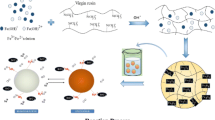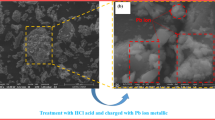Abstract
Microwave-promoted phthalic acid–formaldehyde–resorcinol (M-PFR) based chelating resin was synthesized in DMF media at 2.45 GHz and its performance was compared with conventional phthalic acid–formaldehyde–resorcinol (C-PFR) chelating resin, synthesized earlier in our laboratory. M-PFR resin was characterized by FTIR and elemental analysis. Thermal stability and structural morphology of the synthesized resin were evaluated by TGA, SEM, and BET analysis. The energy of activation (E a) was estimated by thermal analysis data using Broido and Horowitz–Metzger methods. The physico-chemical properties of M-PFR resin have also been determined. The adsorption capacities of M-PFR resin for Cr(III) and Pb(II) have been studied by batch equilibrium method, and were found maximum 0.43 and 3.12 mmol/g at pH 6.0, respectively. Operational variables such as pH, metal concentration and equilibrium rate were optimized. The sorption equilibrium data follow Langmuir and Freundlich adsorption models. A pseudo-second order kinetic model has been proposed to correlate the data. Sequestration of Cr(III) and Pb(II) from estuarine sediment extract was carried out at optimized K d values in tartaric acid media by column method. The regeneration of M-PFR resin was successfully carried out by 2 M HCl and reused several times.















Similar content being viewed by others
References
Srinivasan K, Tharanitharan V (2009) Removal of Ni(II) from water and wastewater using modified Duolite XAD-761 resin. Indian J Chem Technol 16:245–253
Yusof AM, Chia CH, Wood AKH (2007) Speciation of Cr(III) and Cr(VI) in surface waters with a Chelex-100 resin column and their quantitative determination using inductively coupled plasma mass spectrometry and instrumental neutron activation analysis. J Radioanal Nucl Chem 273:533–538
Sari A, Tuzen M, Citak D, Soylak M (2007) Equilibrium, kinetic and thermodynamic studies of adsorption of Pb(II) from aqueous solution onto Turkish kaolinite clay. J Hazard Mater 149:283–291
Ozdes D, Gundogdu A, Kemer B, Duran C, Senturk HB, Soylak M (2009) Removal of Pb(II) ions from aqueous solution by a waste mud from copper mine industry: equilibrium, kinetic and thermodynamic study. J Hazard Mater 166:1480–1487
Ghaedi M, Ghezelbash GR, Marahel F, Ehsanipour S, Najibi A, Soylak M (2010) Equilibrium, thermodynamic and kinetics studies on Pb(II) biosorption from aqueous solution by Saccharomyces cerevisiae biomass. Clean-Soil Air Water 38:877–885
Kabdasli I, Arslan T, Hanci TO, Alaton IA, Tunay O (2009) Complexing agent and heavy metal removals from metal plating effluent by electrocoagulation with stainless steel electrodes. J Hazard Mater 165:838–845
Mukherji S, Ruparelia JP, Duttagupta SP, Chatterjee AK (2008) Potential of carbon nanomaterials for removal of heavy metals from water. Desalination 232:145–156
Barat R, Bouzas A, Marti N, Ferrer J, Seco A (2009) Precipitation assessment in wastewater treatment plants operated for biological nutrient removal: a case study in Murcia, Spain. J Environ Manag 90:850–857
Zaheri A, Moheb A, Keshtkar AR, Shirani AS (2010) Uranium separation from wastewater by electrodialysis. Iran J Environ Health Sci Eng 7:429–436
Lee SH, Bade R (2011) A review of studies on micellar enhanced ultrafiltration for heavy metals removal from wastewater. J Water Sustain 1:85–102
Li CW, Cheng CH, Choo KH, Yen WS (2008) Polyelectrolyte enhanced ultrafiltration (PEUF) for the removal of Cd(II): effects of organic ligands and solution pH. Chemosphere 72:630–635
Romero J, Valdes H, Sanchez J, Bocquet S, Rios GM, Valenzuela F (2009) Characterization of chemical kinetics in membrane-based liquid–liquid extraction of molybdenum(VI) from aqueous solutions. Chem Eng J 151:333–341
Yue Q, Chen S, Gao B, Xu X (2010) Equilibrium and kinetic adsorption study of the adsorptive removal of Cr(VI) using modified wheat residue. J Colloid Interf Sci 349:256–264
Donia AM, Atia AA, Yousif AM (2003) Synthesis of amine and thio chelating resins and study of their interaction with zinc(II), cadmium(II) and mercury(II) ions in their aqueous solutions. React Funct Polym 56:75–82
Shah BA, Shah AV, Patel NB (2008) Microwave assisted benign method of chelating resin synthesis having different thermal and ion exchange properties. Macromol Symp 274:91–100
Agrawal A, Sahu KK (2006) Separation and recovery of lead from mixture of some heavy metals using Amberlite IRC 718 chelating resin. J Hazard Mater B133:299–303
Agrawal A, Sahu KK, Rawat JP (2003) Kinetic studies on the exchange of bivalent metal ions on Amberlite IRC-718—an iminodiacetate resin. Solvent Extr Ion Exch 21:763–782
Alyuz B, Veli S (2009) Kinetics and equilibrium studies for the removal of nickel and zinc from aqueous solutions by ion exchange resins. J Hazard Mater 167:482–488
Abo-Farha SA, Abdel-Aal AY, Ashour IA, Garamon SE (2009) Removal of some heavy metal cations by synthetic resin Purolite C100. J Hazard Mater 169:190–194
Alberti G, Biesuz R (2006) Empore™ membrane vs. Chelex 100: thermodynamic and kinetics studies on metals sorption. React Funct Polym 71:588–598
Soylak M, Tuzen M (2006) Diaion SP-850 resin as a new solid phase extractor for preconcentration-separation of trace metal ions in environmental samples. J Hazard Mater B137:1496–1501
Pehlivan E, Gode F (2006) Removal of chromium(III) from aqueous solutions using Lewatit S 100: the effect of pH, time, metal concentration and temperature. J Hazard Mater B136:330–337
Dragan ES, Dinu MV, Trochimczuk AW (2009) Sorption of Pb(II), Cd(II) and Zn(II) by iminodiacetate chelating resin in non-competitive and competitive conditions. Desalination 249:374–379
Shah A, Khuhawar MY, Shah AA (2012) Evaluation of sorption behavior of polymethylene-bis(2-hydroxybenzaldehyde) for Cu(II), Ni(II), Fe(III), Co(II) and Cd(II) ions. Iran Polym J 21:325–334
Shah BA, Shah AV, Shah PM (2009) Analytical and morphology studies of phthalic acid–formaldehyde–resorcinol as chelating resin. Malays Polym J 4:1–12
Shah BA, Shah AV, Shah PM (2008) Preparation and analytical properties of amphoteric chelating resin. E-J Chem 5:291–301
Shah BA, Shah AV, Shah PM (2006) Synthesis, characterization, and analytical applications of o-substituted benzoic acid chelating resin. Iran Polym J 15:809–819
Shah BA, Shah AV, Patel NB (2010) Selective sorption of heavy metal ions from aqueous solutions using m-cresol based chelating resin and its analytical applications. Iran J Chem Chem Eng 29:49–58
Jain VK, Pandya RA, Pillai SG, Shrivastav PS (2006) Merrifield resin supported chelate forming Calix[4]arene-o-vanillinthiosemicarbazone resin employed for the separation, preconcentration and trace determination of Cr(VI), As(III) and Tl(I) in water samples. Sep Sci Technol 41:123–147
Das AK, Dutta S (2005) Microwave-assisted synthesis and characterization of a new chelating resin functionalized with 2-aminothiazole: application in trace level cadmium–mercury separation in biological samples. Indian J Chem Technol 12:139–144
Hou LX, Jiang F, Wang S (2008) Synthesis and application of an amino phosphonic acid chelating resin for adsorption of Ce(III). J Anal Chem 63:337–341
Hosseini MS, Bandegharaei AH (2010) Selective extraction of Th(IV) over U(VI) and other co-existing ions using eosin-B impregnated Amberlite IRA-410 resin beads. J Radioanal Chem 283:23–30
Gurnule WB, Singru RN (2010) Chelating ion-exchange properties of copolymer resins derived from p-cresol, oxamide and formaldehyde. Iran Polym J 19:169–183
Gurnule WB, Singru RN (2010) Thermogravimetric study of 8-hydroxyquinoline 5-sulfonic acid–melamine–formaldehyde terpolymer resins-II. J Therm Anal Calorim 100:1027–1036
Das AK, Mondal BC (2002) Microwave assisted synthesis of a new chelating resin containing 2-aminothiophenyl S-acetic acid and its application to the determination of lead. React Funct Polym 53:45–52
Mondal BC, Das AK (2003) Microwave-assisted synthesis of a new resin functionalized with adenine moiety and its application for the separation of zinc and cadmium in microwave-digested industrial sludge samples. Indian J Chem Technol 10:489–494
Orlando US, Baes AU, Nishijima W, Okada M (2002) Preparation of chelating agents from sugarcane bagasse by microwave radiation as an alternative ecologically benign procedure. Green Chem 4:555–557
Li H, Lu J, Ji S, Wang L, Qi X, Xiao M (2004) Synthesis of self-chelating resins by microwave irradiation and studies on the properties. Polym Mater Sci Eng 20:81–84
Kunin R (1958) Ion-exchange resins, 2nd edn. Wiley, New York
Silverstein RM, Webster FX (1998) Spectroscopic identification of organic compounds, 6th edn. Wiley, New York
Broido A (1969) A simple, sensitive graphical method of treating thermogravimetric analysis data. J Polym Sci Part-A-2 7:1761–1773
Horowitz HH, Metzger GA (1963) New analysis of thermogravimetric traces. Anal Chem 35:1464–1468
Doyle CD (1961) Kinetic analysis of thermogravimetric data. J Appl Polym Sci 5:285–292
Chiang CL, Chang RC, Chiu YC (2007) Thermal stability and degradation kinetics of novel organic/inorganic epoxy hybrid containing nitrogen/silicon/phosphorus by sol–gel method. Thermochim Acta 453:97–104
Rao TP, Metilda P, Sanghamitra K, Gladis JM, Naidu GRK (2005) Amberlite XAD-4 functionalized with succinic acid for the solid phase extractive preconcentration and separation of uranium(VI). Talanta 65:192–200
Kolodynska D (2010) The effect of the novel complexing agent in removal of heavy metal ions from waters and waste waters. Chem Eng J 165:835–845
Gode F, Pehlivan E (2003) A comparative study of two chelating ion-exchange resins for the removal of chromium(III) from aqueous solution. J Hazard Mater B100:231–243
Yi J, Rengaraj S, Joo CK, Kim Y (2003) Kinetics of removal of chromium from water and electronic process wastewater by ion exchange resins: 1200H, 1500H and IRN97H. J Hazard Mater B102:257–275
Pehlivan E, Edebali S (2010) Evaluation of Amberlite IRA96 and Dowex 1 × 8 ion-exchange resins for the removal of Cr(VI) from aqueous solution. Chem Eng J 161:161–166
Srinivasan K, Tharanitharan V (2009) Removal of Pb(II) from aqueous solutions by using dioctyl sodium sulphosuccinate-EDTA modified Amberlite XAD-7HP resin. Indian J Chem Technol 16:417–425
Ayranci E, Duman O (2005) Adsorption behaviors of some phenolic compounds onto high specific area activated carbon cloth. J Hazard Mater B124:125–132
Acknowledgments
The authors are grateful to Gujarat Council of Science and Technology (GUJCOST), India (Project file no.: 201426/09-10/3051-3052), for their financial support.
Author information
Authors and Affiliations
Corresponding author
Rights and permissions
About this article
Cite this article
Shah, B.A., Shah, A.V. & Navik, A.J. Microwave-promoted M-PFR resin: kinetics, isotherms and sequestration of Cr(III) and Pb(II) from environmental samples. Iran Polym J 21, 569–582 (2012). https://doi.org/10.1007/s13726-012-0061-y
Received:
Accepted:
Published:
Issue Date:
DOI: https://doi.org/10.1007/s13726-012-0061-y




